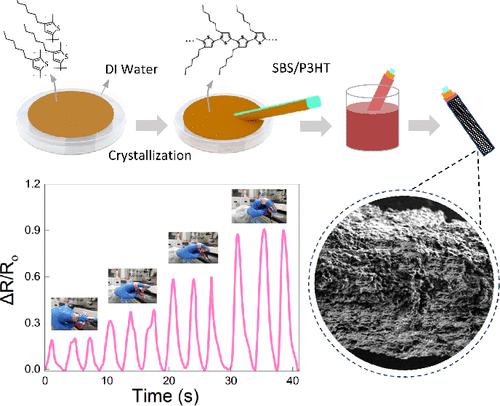Development of a Highly Sensitive and Stretchable Charge-Transfer Fiber Strain Sensor for Wearable Applications
IF 8.3
2区 材料科学
Q1 MATERIALS SCIENCE, MULTIDISCIPLINARY
引用次数: 0
Abstract
Wearable electronics have significantly advanced the development of highly stretchable strain sensors, which are essential for applications such as health monitoring, human-machine interfaces, and energy harvesting. Fiber-based sensors and polymeric materials are promising due to their flexibility and tunable properties, although balancing sensitivity and stretchability remains a challenge. This study introduces a novel composite strain sensor that combines poly(3-hexylthiophene) and tetrafluoro-tetracyanoquinodimethane to form a charge-transfer complex (CTC) with carbon nanotubes (CNTs) on a styrene-butadiene-styrene substrate. The CTC improves conductivity through effective charge transfer, while CNTs provide mechanical reinforcement and maintain conductive paths, preventing cracks under large strains. Purposefully introduced wrinkles in the structure enhance the detection of small strains. The sensor demonstrated a broad strain-sensing range from 0.01 to 200%, exhibiting high sensitivity to both minor and major deformations. Mechanical tests confirmed strong stress-strain performance, and electrical tests indicated significant conductivity improvements with CNT integration. These results highlight the potential of the sensor for applications in health monitoring, human-machine interfaces, and energy harvesting, effectively mimicking the tactile sensing abilities of human skin.

开发用于可穿戴应用的高灵敏度、可拉伸电荷转移光纤应变传感器
可穿戴电子设备极大地推动了高度可拉伸应变传感器的发展,这对于健康监测、人机界面和能量采集等应用至关重要。基于纤维的传感器和聚合物材料因其灵活性和可调特性而大有可为,但如何在灵敏度和可拉伸性之间取得平衡仍是一项挑战。本研究介绍了一种新型复合应变传感器,它将聚(3-己基噻吩)和四氟-四氰醌二甲烷与碳纳米管(CNT)结合,在苯乙烯-丁二烯-苯乙烯基底上形成电荷转移复合物(CTC)。CTC 通过有效的电荷转移提高导电性,而 CNT 则提供机械加固并保持导电路径,防止在大应变下出现裂缝。结构中特意引入的皱纹增强了对微小应变的检测能力。该传感器的应变感应范围很广,从 0.01% 到 200%,对微小和较大的变形都具有很高的灵敏度。机械测试证实了其强大的应力应变性能,电气测试表明,集成碳纳米管后传导性显著提高。这些结果凸显了该传感器在健康监测、人机界面和能量收集方面的应用潜力,有效地模拟了人体皮肤的触觉传感能力。
本文章由计算机程序翻译,如有差异,请以英文原文为准。
求助全文
约1分钟内获得全文
求助全文
来源期刊

ACS Applied Materials & Interfaces
工程技术-材料科学:综合
CiteScore
16.00
自引率
6.30%
发文量
4978
审稿时长
1.8 months
期刊介绍:
ACS Applied Materials & Interfaces is a leading interdisciplinary journal that brings together chemists, engineers, physicists, and biologists to explore the development and utilization of newly-discovered materials and interfacial processes for specific applications. Our journal has experienced remarkable growth since its establishment in 2009, both in terms of the number of articles published and the impact of the research showcased. We are proud to foster a truly global community, with the majority of published articles originating from outside the United States, reflecting the rapid growth of applied research worldwide.
 求助内容:
求助内容: 应助结果提醒方式:
应助结果提醒方式:


